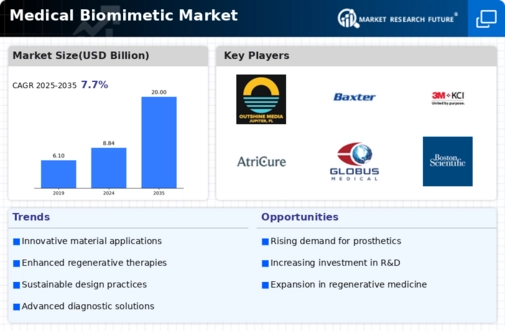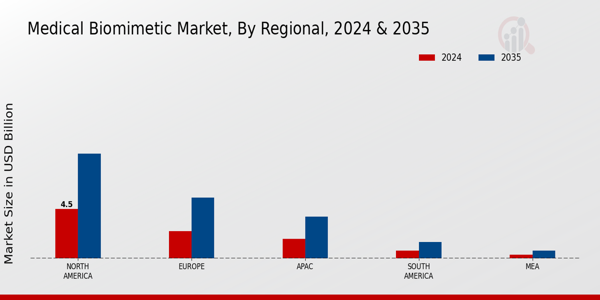Market Growth Projections
The Global Medical Biomimetic Market Industry is projected to experience substantial growth in the coming years, with estimates indicating a market value of 8.84 USD Billion in 2024 and a potential increase to 20 USD Billion by 2035. This growth trajectory suggests a compound annual growth rate (CAGR) of 7.7% from 2025 to 2035. Such projections underscore the increasing relevance of biomimetic technologies in the healthcare sector, driven by advancements in materials science, personalized medicine, and regulatory support. The market's expansion reflects a broader trend towards innovative healthcare solutions that prioritize patient outcomes and address the complexities of modern medical challenges.
Growing Awareness of Personalized Medicine
The growing awareness of personalized medicine is reshaping the landscape of the Global Medical Biomimetic Market Industry. Patients and healthcare providers are increasingly recognizing the benefits of tailored treatments that consider individual genetic and biological factors. Biomimetic technologies play a crucial role in this paradigm shift, enabling the development of customized medical devices and therapies that align with patients' unique needs. This trend is further supported by advancements in genomics and biotechnology, which facilitate the creation of personalized solutions. Consequently, the Global Medical Biomimetic Market Industry is expected to expand as healthcare systems adapt to meet the demand for more individualized approaches to treatment.
Rising Demand for Advanced Healthcare Solutions
The Global Medical Biomimetic Market Industry experiences a surge in demand for advanced healthcare solutions, driven by an aging population and increasing prevalence of chronic diseases. As healthcare systems evolve, there is a notable shift towards innovative treatments that mimic natural biological processes. This trend is reflected in the projected market value of 8.84 USD Billion in 2024, indicating a robust growth trajectory. The integration of biomimetic technologies in medical devices and regenerative medicine is likely to enhance patient outcomes, thereby attracting investments and fostering research initiatives. Consequently, the Global Medical Biomimetic Market Industry is poised for substantial expansion.
Increased Investment in Research and Development
Increased investment in research and development is a pivotal driver for the Global Medical Biomimetic Market Industry. Governments and private entities are recognizing the potential of biomimetic technologies in addressing complex medical challenges. Funding initiatives aimed at fostering innovation in biomimetic applications are on the rise, leading to breakthroughs in areas such as drug delivery systems and regenerative medicine. This influx of capital not only accelerates the development of new products but also enhances collaboration between academia and industry. As a result, the Global Medical Biomimetic Market Industry is likely to witness accelerated growth, with a focus on translating research into practical healthcare solutions.
Technological Advancements in Biomimetic Materials
Technological advancements in biomimetic materials significantly contribute to the growth of the Global Medical Biomimetic Market Industry. Innovations in materials science have led to the development of biocompatible and bioactive materials that closely replicate natural tissues. For instance, the introduction of synthetic polymers that mimic the extracellular matrix has revolutionized tissue engineering applications. These advancements not only improve the functionality of medical devices but also enhance their integration within the human body. As a result, the market is expected to grow at a CAGR of 7.7% from 2025 to 2035, reaching an estimated value of 20 USD Billion by 2035.
Regulatory Support for Innovative Medical Solutions
Regulatory support for innovative medical solutions is a key factor influencing the Global Medical Biomimetic Market Industry. Governments worldwide are increasingly recognizing the importance of fostering innovation in healthcare through streamlined regulatory processes. Initiatives aimed at expediting the approval of biomimetic products are gaining traction, thereby encouraging companies to invest in research and development. This supportive regulatory environment not only enhances market entry for new technologies but also promotes competition among industry players. As a result, the Global Medical Biomimetic Market Industry is likely to experience accelerated growth, driven by the introduction of novel biomimetic solutions that address unmet medical needs.




















